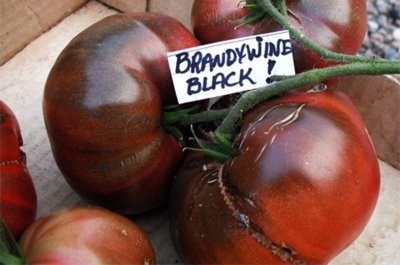
- Authors: USA
- Name synonyms: BRANDYWINE
- Category: grade
- Growth type: indeterminate
- Appointment: universal
- Ripening period: mid-season
- Ripening time, days: 110-120
- Growing conditions: for closed ground
- Bush size: medium-sized
- Bush height, cm: 120-180
Brandywine is a tomato variety bred by US breeders. This variety is not so common in Russian summer cottages. This is due to some features of the plant of foreign selection. Let's take a closer look at this variety.
Description of the variety
This is a culture of an indeterminate type. The bush is characterized by medium vigor, its height reaches 120-180 cm. The leaves are similar to potato leaves.
The main qualities of the fruit
Unripe tomatoes are green in color, with a dark green spot at the base. The ripe fruit is brown-red in color. Tomatoes are large, weight - 220-450 g, flat-round shape, few seeds, especially in small late specimens. These tomatoes do not have a long shelf life, so gardeners do not recommend planting a large number of bushes.
Taste characteristics
One of the main advantages of the variety is the taste of the fruit. The pulp is very sweet, tender, sugar, melts in the mouth, when consumed, there is a slight aftertaste of tropical fruits. This is a versatile variety, that is, it can be used both for fresh consumption and for preparations, however, the first option is more preferable, especially brightly such fresh tomatoes will be felt in the salad with green leaves.
Ripening and fruiting
Brandywine refers to varieties with a mid-ripening period, the first fruits can be removed after 110-120 days.
Yield
Judging by the reviews of summer residents, the yield is more close to an average or even small degree, which is typical for varieties of foreign selection. But often come across large tomatoes weighing almost 500 g. Later tomatoes are smaller, but their taste is more pronounced.
The timing of planting seedlings and planting in the ground
Sowing for seedlings is carried out at least two months before planting in the ground.

Growing tomato seedlings is an extremely important process, because it largely depends on whether the gardener will be able to harvest at all. All aspects must be taken into account, from seedbed preparation to planting in the ground.
Landing scheme
Seeds are sown to a depth of 2-3 mm in a container with a substrate. Next, you need to sprinkle the soil with water and cover with a film. The first shoots will hatch in 6-14 days. Seedlings will feel comfortable with a 16-hour daylight hours and a temperature of + 18 ... + 23 degrees. All this time, the sprouts need mineral and organic fertilizers.
When 2 leaves appear, the seedlings dive, and when they reach a height of 20 cm, they are transplanted to a summer cottage. The distance between future bushes should not be less than 45 cm. Transplantation consists of the following stages.
- Put wood ash and special additives for tomatoes at the bottom of the hole, well mixed with ordinary soil.
- Carefully remove each sprout with a clod of earth and plant it to a depth of 10-15 cm.
- Water the roots abundantly without hitting the seedling.
- Lay out a layer of mulch such as peat.
- Insert a stake near the planting site and tie up the young seedling.
- Keep the young plant covered for a while to create a greenhouse effect.

Growing and care
When caring for a plant, follow a few guidelines.
- The culture of the presented variety is usually grown in greenhouses. The plant is regularly tied up, side shoots and lower leaves are eliminated. It is important to loosen and mulch the soil, as well as form a culture, lead in 2-3 stems.
- The variety requires watering once a week. Each bush needs 1 liter of water per intake. Irrigation is recommended on a cloudy day or in the evening. Watering should be stopped two weeks before harvesting.
- The first fertilization is applied 10-14 days after transplanting. As a top dressing, a mullein mixed with superphosphate and water is suitable. After another couple of weeks, treatment with dry mineral compounds should be carried out, adding them under the bushes after loosening. After another two weeks, mineral mixtures will again be required, for example, a composition of superphosphate, potassium salt, ammonium nitrate.
The variety is characterized by high immunity to fungal diseases and the tobacco mosaic virus, so it needs minimal preventive treatments.




A plant needs different micronutrients at each stage of growth. All fertilizers can be divided into two groups: mineral and organic. Folk remedies are often used: iodine, yeast, bird droppings, eggshells.
It is important to observe the rate and period of feeding. This also applies to folk remedies and organic fertilizers.



























































































